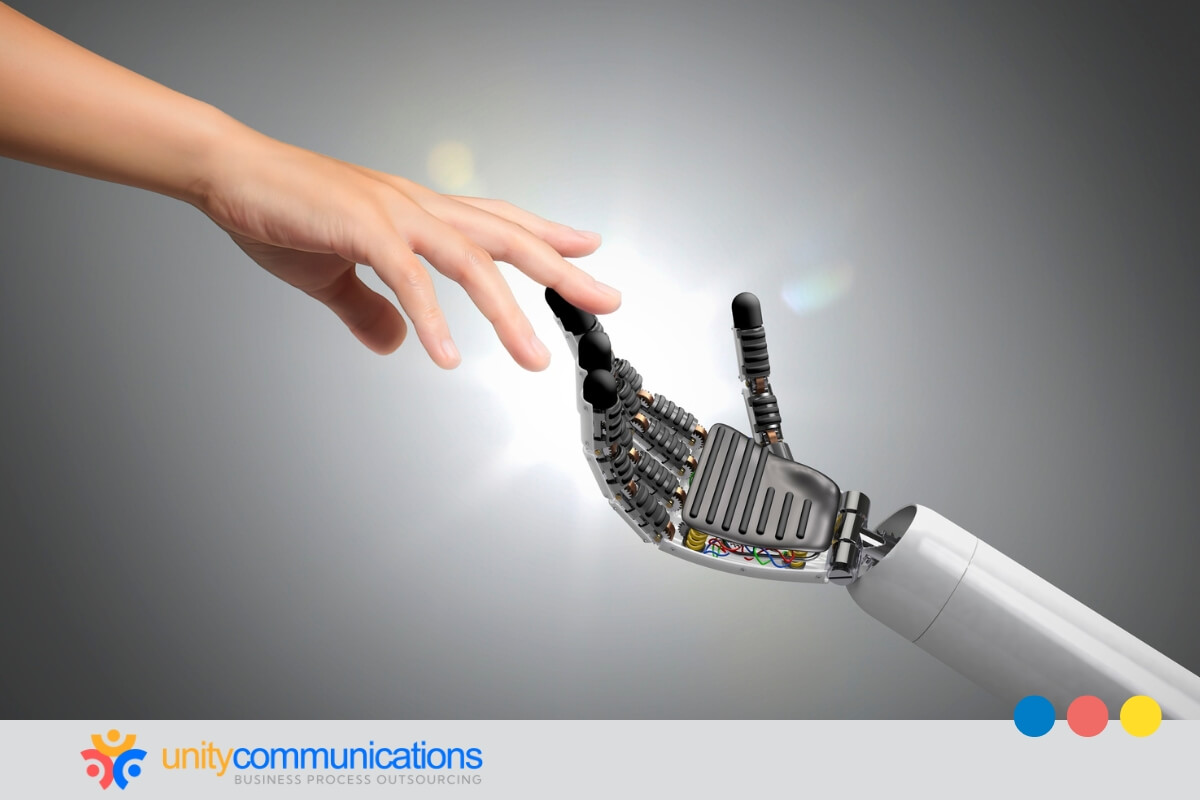Table of Contents
How does artificial intelligence (AI) transform your company’s external operations? Business process outsourcing (BPO) allows you to transfer tasks for streamlined workflows, but optimizing external processes with AI takes efficiency to another level. The technology reduces errors and optimizes processes.
This article explores how AI innovation refines external operations and helps businesses stay competitive. Keep reading to discover the latest advancements and practical applications.
Introduction to AI in external process optimization

What is BPO, and how does it work with AI to optimize external processes? Outsourcing enables your company to delegate non-core activities to a service provider to free internal resources for critical initiatives.
AI introduces automation, data analysis, and predictive decision-making into your outsourced operations. These solutions significantly boost business process management and efficiency by streamlining workflows, reducing human intervention, and monitoring tasks in real time.
A 2024 McKinsey survey reports that 65% of organizations now use generative AI technology in at least one business function. This shift strengthens AI’s role in enhancing external processes.
From automating tasks in supply chain management to using natural language processing (NLP) for customer support, AI refines the optimization process by analyzing historical data, handling repetitive tasks, and driving improved operational efficiency.
Benefits of optimizing external processes with AI
A 2023 Statista survey reveals that 43% of CEOs and 39% of CMOs plan to explore AI adoption, underscoring its growing significance in optimizing business processes.
The benefits of AI are multifold. In addition to enhancing the efficiency and accuracy of external operations, it allows internal teams to focus on high-value tasks. Other advantages include the following:
- Scalability. AI–powered systems can manage higher workloads without needing more resources.
- Process automation. Organizations reduce their dependence on manual input, resulting in faster routine procedures, fewer delays, and increased precision.
- Improved decision-making. AI examines historical data and detects patterns to aid strategic planning.
- Real-time monitoring. Businesses get constant supervision of external processes for shorter response times.
- Cost efficiency. AI and machine learning (ML) automate tasks, lowering operating expenses while maintaining service quality.
How to identify processes for AI integration
Optimizing external processes with AI involves finding the operational aspects to automate and improve. The technology is usually the most valuable in tedious, data-driven, or time-consuming processes.
To know which components can benefit from AI, analyze them according to their complexity, volume, and potential for efficiency improvements. The main points to evaluate include:
- Repetitive workflows. AI automates data input, document processing, scheduling, and other routine activities, lowering manual workload and human error.
- Data-intensive operations. AI systems examine massive datasets to spot trends, increase efficiency, and facilitate data-driven decision-making.
- Bottlenecks and inefficiencies. AI provides real-time tracking to determine issues, anticipate problems, and expedite operations.
- Scalability requirements. AI-driven automation benefits processes that require rapid alterations, allowing for seamless expansion.
- Error-prone tasks. AI reduces human errors in financial transactions, quality control, compliance audits, and reporting.
AI tools and technologies for process optimization
Market projections estimate AI for process optimization will reach $113.1 billion by 2034, reflecting its growing adoption across industries. AI enables companies to streamline operations, automate workflows, and enhance decision-making.
However, optimizing external processes with AI relies on advanced technologies and tools that improve efficiency, precision, and scalability. The following are excellent examples:
- ML analyzes previous data to detect patterns, predict outcomes, and refine operational strategies.
- AI systems for process automation minimize manual input, accelerate routine tasks, and reduce bottlenecks.
- Intelligent data analytics extracts actionable insights from complex datasets, identifying potential inefficiencies.
- NLP enhances communication, customer interactions, document processing, data classification, and workflow automation.
- Robotic process automation (RPA) handles repetitive functions, freeing human resources for strategic initiatives and high-priority tasks.
Steps to implement AI in external workflows

Deploying AI in external workflows necessitates a methodology that aligns automation with your company’s goals. A solid strategy enables you to properly execute AI-driven solutions while minimizing interruptions.
Consider the steps below:
- Evaluate operational requirements. Define workflows with high volume, frequent failures, or time-sensitive tasks that can benefit from AI-driven automation.
- Choose AI solutions. Select process-specific technology, including ML for data analysis, NLP for communication, and RPA for repetitive operations.
- Integrate with current systems. AI technologies should blend smoothly with enterprise software, databases, and online systems to provide uniformity across processes.
- Maintain and improve. Ongoing assessment aids in discovering inefficiencies, maximizing AI performance, and modifying techniques for improved results.
- Instruct your teams. Employees should grasp AI capabilities, assess findings, and modify workflows to improve productivity.
Challenges in AI adoption and how to address them
Although more businesses leverage AI, automation in the BPO industry does encounter challenges that affect efficiency. The following enumerates the common problems and their solutions:
- Data quality concerns. AI depends on high-quality, structured data to produce reliable results. Organizations should standardize data collection processes and fine-tune datasets to enhance AI performance.
- Integration complexity. Combining AI with current systems can increase the risk of incompatibility. Choosing AI technologies suitable for enterprise applications simplifies the integration process.
- Workforce adaptation. Some workers might decline AI adoption owing to job security concerns. Educational initiatives should emphasize AI’s role in supplementing, rather than replacing, human expertise.
- Regulatory compliance. AI systems must adhere to industrial regulations. Businesses should establish governance structures and perform regular compliance audits.
Managing data security and compliance in AI processes
BPO’s role in AI transformation involves handling confidential client information, making robust security frameworks essential. Protect sensitive data with these strategies:
- Data encryption and access controls. Encrypting sensitive data and implementing role-based access restricts unauthorized use. Multi-factor authentication further strengthens security.
- Regulatory compliance alignment. AI processes should comply with industry-specific regulations, including the Health Insurance Portability and Accountability Act of 1996 and the General Data Protection Regulation. Establishing governance policies maintains adherence to legal requirements.
- AI model transparency. Understanding AI decision-making helps mitigate compliance risks. Documenting AI processes and auditing model outputs support accountability.
- Third-party security protocols. Vendors handling AI-driven processes must align with security policies. Regular assessments verify data protection measures.
How to measure success in AI-driven process improvements
Improving external processes with AI requires setting clear benchmarks to gauge efficiency, precision, and impact. Without measurable indicators, businesses risk missing out on AI’s actual value.
Below are the key performance indicators (KPIs) to help track AI’s effectiveness:
- Operational efficiency. AI automation should boost speed, refine workflows, and cut manual tasks. Tracking completion rates can show improvements.
- Error reduction. AI tools should reduce errors in data entry and reporting. Comparing rates before and after adoption can illustrate the impact.
- Cost savings. AI should cut costs by reducing labor-heavy tasks. Reviewing staffing and workflow expenses can highlight savings.
- Scalability. AI should handle higher workloads without added resources. Monitoring system responsiveness and uptime can assess scalability.
- User adoption. AI should boost productivity. Tracking feedback and task completion rates can identify areas for improvement.
Balancing AI automation with human oversight

Human supervision remains vital for decision-making and adaptability amid technological progress. By balancing automation and human intervention to maintain accuracy, compliance, and operational integrity, you can maximize the benefits of optimizing external processes with AI.
The following illustrates the point:
- Decision-making control. AI automates repetitive operations, while human judgment refines complicated decisions that require context and ethical concerns.
- Process monitoring. Regular audits and real-time tracking aid in detecting AI-driven problems or discrepancies that require human intervention.
- User training and engagement. Employees must comprehend AI-driven procedures, evaluate insights, and make appropriate changes.
- Exception handling. Human skill resolves anomalies and unanticipated obstacles, whereas AI follows predefined patterns.
- Lawful operations. AI must follow government standards, with human oversight, to maintain conformity to changing policies.
Future trends in AI for external operations
AI continues to reshape external functions, boosting efficiency and adaptability. As organizations adopt AI to streamline operations, they must take note of emerging trends that may influence their BPO workflows.
Here are the key developments to watch:
- AI-driven decision intelligence. AI analyzes past and real-time data to improve planning, risk assessment, and decision-making.
- Adaptive AI models. Unlike static AI systems, adaptive models continuously refine processes by learning from operational data, improving response accuracy in dynamic environments.
- AI-powered compliance monitoring. Businesses use AI to track regulatory updates and flag potential compliance risks, reducing manual reviews.
- Edge AI for decentralized operations. AI processing at the data source enhances real-time responsiveness, benefiting remote monitoring industries.
- Advancements in process automation. AI further improves optimizing external processes with AI to reduce bottlenecks and enhance operational continuity.
The bottom line
Do you want to improve efficiency in outsourcing operations? Optimizing external processes with AI enhances workflow automation, reduces errors, and strengthens decision-making. By integrating AI-driven solutions, businesses can refine strategies, cut costs, and boost productivity across various functions.
Stay ahead with more innovative, data-driven processes that adapt to industry demands. Let’s connect and discuss how our team and AI can improve your external workflows and drive better business outcomes.




